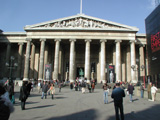Hello Photorealism – Goodbye Pop Art
Originally published in July 2006 in American in Britain Magazine
Forget cartoons and huge billboards. Pop Art has moved into the wings to make way for Photorealist art. Today the popularity and importance of Photorealist art is fully established within many mainstream galleries and museums.
“Your looks are laughable, unphotographable—Yet you’re my favorite work of art”
(lyric – My Funny Valentine – by Rogers & Hart)
Forget cartoons and huge billboards. Pop Art has moved into the wings to make way for Photorealist art. Familiar photographic images and icons – such as Warhols and Lichtensteins – largely appropriated from commercial advertising and comic strips may not have lost their appeal, but today the popularity and importance of Photorealist art is fully established within mainstream galleries and museums. Described as a movement beginning in 1960s USA, Photorealism is difficult to define precisely. Photorealist artists often rely on cameras instead of sketchpads. These painters use sophisticated techniques in order to transfer camera images to the painting surface by means of a grid or projector. Arguably, their aim is to make a painting look photographic.
But are Photorealist paintings works of art? Do photographs represent valid sources of inspiration for painters? The debate about the legitimate role of photography as source material for artists has raged for years. In the mid 19th century, John Ruskin, (The Stones of Venice, 1850s) began a series of architectural drawings from photographs. Ultimately he came to see the photograph as false, merely an ingenious form, whereas art was a matter of genius. By contrast, 17th century Dutch still life and genre paintings, which depicted literal representations of life with a high degree of finish, are comparable to works by contemporary photorealist painters. Today’s photorealist artists are able to convey their unique visual language on canvas by combining sophisticated late 20th and 21st century advances in photography with artistic imagination and skill.
What is the creative process used by photorealist artists? A familiar example is Chuck Close’s enlarged versions of snapshot photographs. Close deliberately reproduces aberrations which the camera allows. His image of the head is presented in different ways with no attempt at photographic reproduction. He aims to challenge and refresh the spectator’s vision of reality. Together with the work of other photorealist artists, this approach allows for and encourages interpretive criticism. These painters are master craftsman and women who combine time-honoured methods with careful planning and precise control during this lengthy process. Their styles and themes encompass a wide array of subject matter. Classical architecture, landscapes, portraits and interiors, as well as familiar icons and the blatant banality of ordinary daily lives are vividly portrayed. These are serious, often satirical and humorous images, which engage the viewer in a dialogue between what they already know and what they might still discover. Let’s look at a few.
Noted photorealist painter, Andrew Holmes, has captured a genuine American icon: the customised cabin of a glowing truck with its steel architecture (seen here). He has painted it meticulously with baroque curves in gleaming oranges and pearlised surfaces. This is a mesmerising vision. The viewer almost feels it rumbling along open roads. Holmes’ view is of vehicles as almost-human modes of transport common on U.S. highways. Simultaneously he reveals the truck as much more than a mere form of transport; it is a uniquely American symbol. Holmes has an insatiable need to analyse and record the fetishes of a blue collar trucking culture as well as trailers, tanks, and motorcycles.
Randy Dudley’s ‘Ruined Building on South Canal, Chicago’ (seen here) captures a view of the industrial wasteland so common today on the outskirts of American cities. Local manufacture once energised and brought wealth to U.S. cities. What we see here is a decaying building with broken windows, dump trucks, broken tractors and scrap heaps. Evocations of a once affluent age, Dudley’s paintings are reminders of what has been lost. They convey a store of images which document industrial landscapes, bridges, docklands and dumps.
Jack Mendenhall’s work explores remarkable scenic views of the contemporary nouveau riche at leisure (see here: ‘Woman in a Red Suit’). His large canvases, some six by seven feet, look fabulous on walls. He has captured the extraordinary light and colour of Caribbean and Pacific resorts. Evocative of advertising images, many of his paintings encapsulate the allure of lush tropical climates. One might ask: why take a holiday to these places when you can live with them in your home?
‘Meticulous’ sums up the visions in British-born Simon Hennessey’s work. In ‘Under Surveillance’ (seen here) Hennessey aims to change a photographic language into a painted language. He seeks to deceive the human eye by producing paintings that are mimetic of photographs. He distorts focus, tonality, depth and focal points, and calls the final image ‘photoreality’. Hennessey’s process is one whereby he desaturates colour, crops and uses a close-up that distorts his subject’s identity. In ‘Under Surveillance’, her eyes dominate. Gazing at this image, your imagination takes over.
Can we find humour, satire and kitsch in Photorealist paintings? Where better than in the work of four artists: Cynthia Poole, Elena Molinari, Cesar Santander and Tjalf Sparnaay. Poole moved to London from Zimbabwe and worked as an landscape architect where she specialised in producing architectural visualisations. In 2000 she began to paint still lives of mass-market candy and food products. Her ‘Toffee Crisp’ (seen here) consists of multiple candy bars. Molinari’s everyday consumer subject matter complements Cynthia Poole’s. Her crushed ‘fizzy drink’ tins (seen here) make a glossy conspicuously commercial statement. Toys feature in Cesar Santander’s work. ‘Tom and Jerry’ (seen here) encapsulates his outlandish sense of humour. Santander’s paintings are highly collectable, especially his portrait of ‘Betty Boop’. His work evokes some of the same elements found in Jeff Koons’ sculptures. Dutch artist, Tjalf Sparnaay, has had fun playing around with Vermeer’s ‘The Girl With the Pearl Earring’, a classic Old Master painting. Sparnaay’s representation of ‘Girl with a Pearl Earring in Plastic’ (seen here) is humorous, classical and light-hearted. He also enjoys depicting popular icons such a catsup bottles and lollypops.
Elegance and classical imagery are powerfully portrayed in Carl Laubin’s brilliant architectural compositions. Laubin succeeds in depicting a composite of buildings in ‘Another Professors Tribute’ (seen here). Light fuses through a partial view of the rotunda. Arches, columns, Greek statues and all manner of grand temples intellectualize what is a highly individual – almost poetic take on classical design and decoration. The density and depth of Laubin’s work is overwhelming. American born, architecturally trained, but now British based, Laubin has had many commissions. Of particular note are his paintings of the Canary Wharf development. His recent works have explored the nature of classical drapery on female statues.
This discussion has highlighted only a few of the many artists working as Photorealists today. Now that Photorealism in painting is established and respected, contemporary art dealers, collectors, public galleries and museums compete to obtain these ‘photographical’ paintings. This style of painting deserves more attention. Surely these images encourage viewers to look beneath the surface reality.
*********************************************************************
References:
Lucie-Smith E. American Realism Thames & Hudson 1994
Meisel L. Photorealism at the Millennium Harry Abrams, Inc Publishers 2002
Visit the
PLUS ONE GALLERY
91 Pimlico Road, London SW1W 81H
Tel: 020 7730 7656 Fax: 020 7730 7664
info@plusonegallery.com
www.plusonegallery.com
Contact Abby Cronin: artsjournalist@abbycronin.co.uk
Website: www.abbycronin.co.uk




